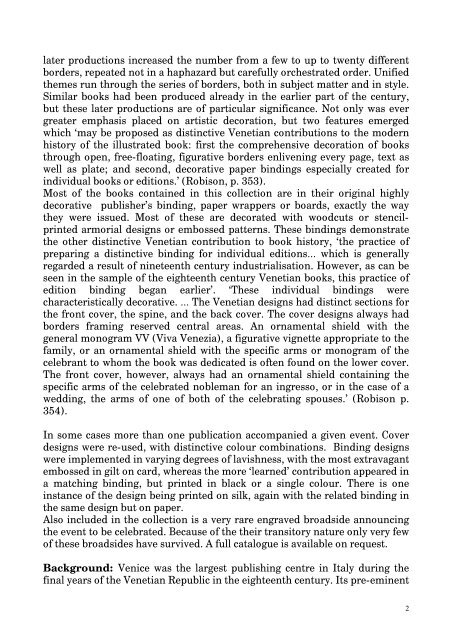Susanne Schulz-Falster Rare Books A magnificent collection of forty ...
Susanne Schulz-Falster Rare Books A magnificent collection of forty ...
Susanne Schulz-Falster Rare Books A magnificent collection of forty ...
Create successful ePaper yourself
Turn your PDF publications into a flip-book with our unique Google optimized e-Paper software.
later productions increased the number from a few to up to twenty different<br />
borders, repeated not in a haphazard but carefully orchestrated order. Unified<br />
themes run through the series <strong>of</strong> borders, both in subject matter and in style.<br />
Similar books had been produced already in the earlier part <strong>of</strong> the century,<br />
but these later productions are <strong>of</strong> particular significance. Not only was ever<br />
greater emphasis placed on artistic decoration, but two features emerged<br />
which ‘may be proposed as distinctive Venetian contributions to the modern<br />
history <strong>of</strong> the illustrated book: first the comprehensive decoration <strong>of</strong> books<br />
through open, free-floating, figurative borders enlivening every page, text as<br />
well as plate; and second, decorative paper bindings especially created for<br />
individual books or editions.’ (Robison, p. 353).<br />
Most <strong>of</strong> the books contained in this <strong>collection</strong> are in their original highly<br />
decorative publisher’s binding, paper wrappers or boards, exactly the way<br />
they were issued. Most <strong>of</strong> these are decorated with woodcuts or stencilprinted<br />
armorial designs or embossed patterns. These bindings demonstrate<br />
the other distinctive Venetian contribution to book history, ‘the practice <strong>of</strong><br />
preparing a distinctive binding for individual editions… which is generally<br />
regarded a result <strong>of</strong> nineteenth century industrialisation. However, as can be<br />
seen in the sample <strong>of</strong> the eighteenth century Venetian books, this practice <strong>of</strong><br />
edition binding began earlier’. ‘These individual bindings were<br />
characteristically decorative. … The Venetian designs had distinct sections for<br />
the front cover, the spine, and the back cover. The cover designs always had<br />
borders framing reserved central areas. An ornamental shield with the<br />
general monogram VV (Viva Venezia), a figurative vignette appropriate to the<br />
family, or an ornamental shield with the specific arms or monogram <strong>of</strong> the<br />
celebrant to whom the book was dedicated is <strong>of</strong>ten found on the lower cover.<br />
The front cover, however, always had an ornamental shield containing the<br />
specific arms <strong>of</strong> the celebrated nobleman for an ingresso, or in the case <strong>of</strong> a<br />
wedding, the arms <strong>of</strong> one <strong>of</strong> both <strong>of</strong> the celebrating spouses.’ (Robison p.<br />
354).<br />
In some cases more than one publication accompanied a given event. Cover<br />
designs were re-used, with distinctive colour combinations. Binding designs<br />
were implemented in varying degrees <strong>of</strong> lavishness, with the most extravagant<br />
embossed in gilt on card, whereas the more ‘learned’ contribution appeared in<br />
a matching binding, but printed in black or a single colour. There is one<br />
instance <strong>of</strong> the design being printed on silk, again with the related binding in<br />
the same design but on paper.<br />
Also included in the <strong>collection</strong> is a very rare engraved broadside announcing<br />
the event to be celebrated. Because <strong>of</strong> the their transitory nature only very few<br />
<strong>of</strong> these broadsides have survived. A full catalogue is available on request.<br />
Background: Venice was the largest publishing centre in Italy during the<br />
final years <strong>of</strong> the Venetian Republic in the eighteenth century. Its pre-eminent<br />
2
















